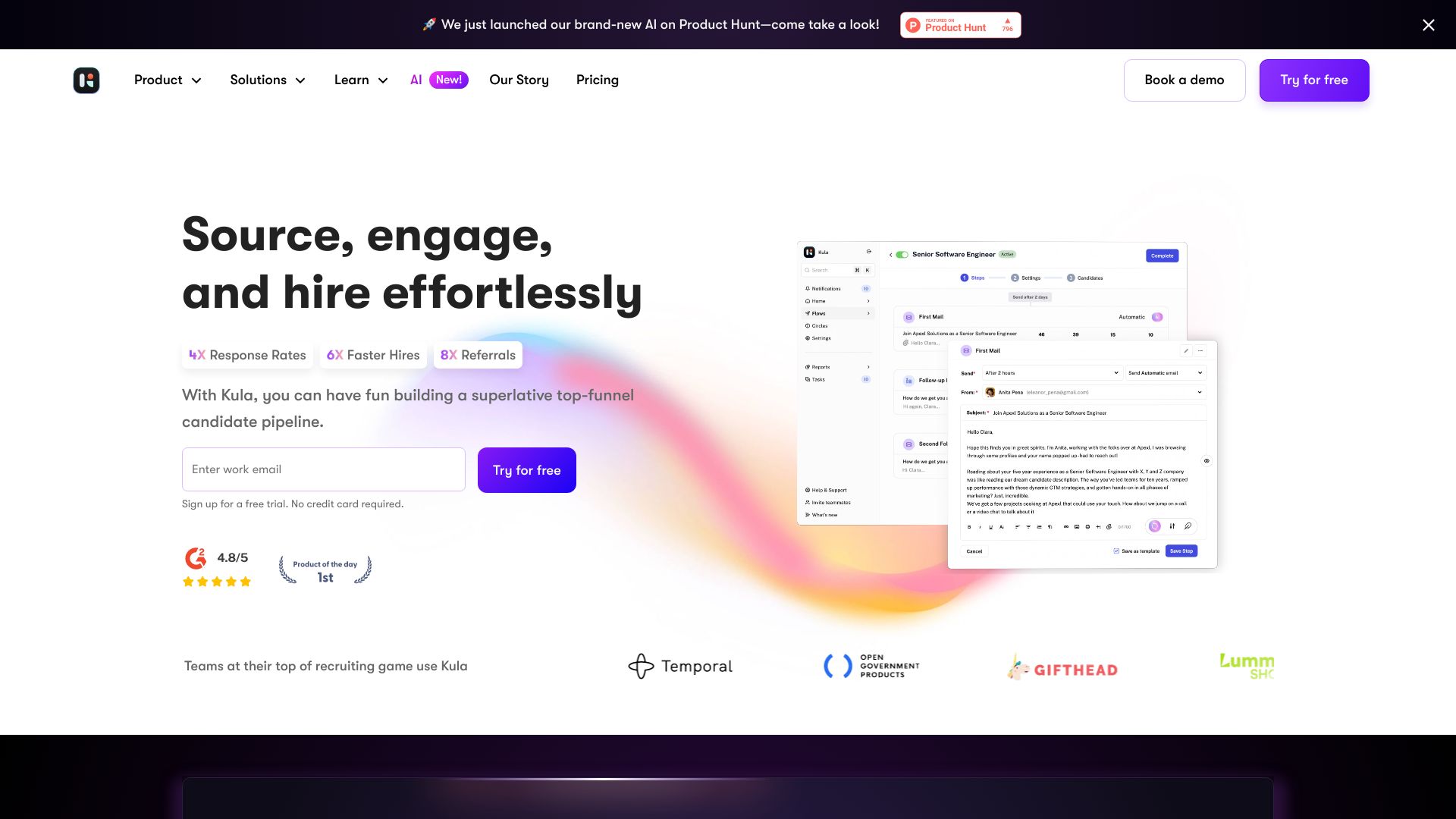- Home
- AI Summarizer
- Kula AI

Kula AI
Open Website-
Tool Introduction:Kula AI unifies native-AI sourcing, tracking, and hiring insights.
-
Inclusion Date:Oct 28, 2025
-
Social Media & Email:
Tool Information
What is Kula AI
Kula AI is an all-in-one Applicant Tracking System (ATS) that embeds native AI across the entire hiring journey. It unifies AI-powered candidate sourcing, applicant tracking, interview intelligence, and hiring analytics so teams can move from manual tasks to consistent, data-informed decisions. With intelligent search and ranking, automated workflows, structured scorecards, and insight-rich dashboards, Kula AI helps recruiters and hiring managers find qualified talent faster, run better interviews, and understand what drives time-to-hire and quality-of-hire at scale.
Kula AI Main Features
- AI-powered candidate sourcing: Surface relevant profiles, expand talent pools, and prioritize candidates based on role requirements and historical signals.
- Smart resume parsing and ranking: Automatically extract skills and experience, then rank candidates to reduce manual screening time.
- Applicant tracking pipelines: Visual pipelines, stage management, and bulk actions to keep every candidate moving efficiently.
- Automated outreach and scheduling: Template-based emails, reminders, and calendar coordination to streamline coordination.
- Interview intelligence: AI-assisted notes, summaries, and structured question guides to drive consistent, fair interviews.
- Scorecards and feedback: Standardized evaluation frameworks that align interviewers and improve hiring signal quality.
- Hiring analytics and insights: Track time-to-hire, stage conversion, source effectiveness, and pipeline health for data-driven decisions.
- Collaboration and permissions: Role-based access, @mentions, and shared views to align recruiters and hiring managers.
- Customizable workflows: Tailor stages, templates, and automations to fit different roles, teams, and hiring volumes.
- Privacy-aware candidate management: Centralized records and access controls to help safeguard candidate information.
Who Should Use Kula AI
Kula AI is ideal for in-house talent acquisition teams, recruiters, HR leaders, hiring managers, and recruiting coordinators seeking an AI ATS to scale hiring. It suits startups building their first process, mid-market companies standardizing across teams, and larger organizations aiming to consolidate tooling, improve interview consistency, and gain actionable hiring analytics. Agencies and RPOs can also benefit from faster sourcing and streamlined collaboration with client stakeholders.
Kula AI How-To Steps
- Set up your workspace: create your company profile, roles, permissions, and email/calendar connections.
- Create or import jobs: define requirements, must-have skills, and hiring teams for each open role.
- Configure pipelines: customize stages, SLAs, and scorecards aligned to each role’s evaluation criteria.
- Source candidates: use AI search to build shortlists and import applicants from inbound channels.
- Automate engagement: send personalized outreach, reminders, and schedule screens and interviews.
- Run structured interviews: use guides and scorecards; capture notes and AI-assisted summaries.
- Advance decisions: compare evaluations, collaborate with stakeholders, and move to offer.
- Review analytics: monitor stage conversion, time-to-fill, and source performance to optimize.
Kula AI Industry Use Cases
A SaaS startup accelerates engineering hires by using AI ranking to surface qualified candidates and standardized scorecards to reduce noise in interviews. A retail organization manages seasonal spikes with automated screening, bulk actions, and quick scheduling. A professional services firm improves consistency across offices by enforcing structured interviews and tracking stage-level conversion to prioritize process improvements.
Kula AI Pros and Cons
Pros:
- Unified platform from sourcing to hiring analytics, reducing tool fragmentation.
- AI-assisted ranking and summaries cut manual screening and note-taking.
- Structured interviews and scorecards improve fairness and decision quality.
- Customizable workflows adapt to diverse roles and team processes.
- Collaboration features align recruiters, coordinators, and hiring managers.
- Actionable insights help optimize time-to-hire and source effectiveness.
Cons:
- Effective use may require initial setup, data hygiene, and change management.
- AI recommendations still need human oversight and calibration.
- Integration depth can vary; teams may need to align existing systems and processes.
- Costs can scale with seats and feature usage, depending on plan structure.
Kula AI FAQs
-
Is Kula AI an ATS or just a sourcing tool?
It is an all-in-one ATS with native AI, spanning candidate sourcing, applicant tracking, interview intelligence, and hiring insights.
-
How does the AI improve hiring outcomes?
It accelerates shortlisting with matching and ranking, automates routine outreach and scheduling, and provides interview summaries and analytics to inform decisions.
-
Can Kula AI replace recruiters?
No. It augments recruiters and hiring managers by removing manual work and highlighting insights, while final decisions remain human-led.
-
What metrics can teams track?
Common metrics include time-to-hire, time-in-stage, stage conversion rates, source performance, pipeline health, and interview throughput.
-
Does it work with existing tools?
Teams typically connect email and calendars and align workflows with their current stack. For specific integrations, review the vendor’s official documentation.



